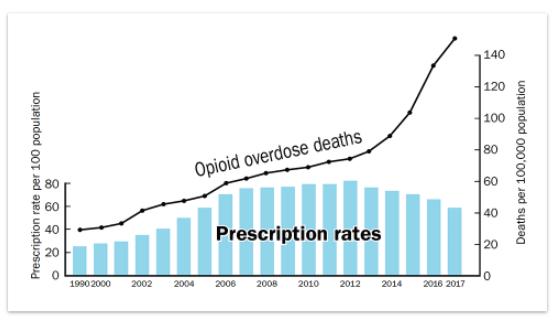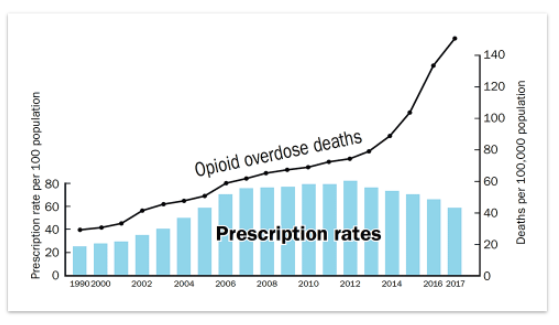
Robert Hart writes about business for Forbes. I write about drugs for ACSH.
We ought not switch jobs.
I'm fairly confident that I could bring down the entire Western economy with an article or two. Yes, I'm that unqualified. Whether Hart's ignorance about the so-called opioid crisis reaches that of my potential ineptitude on economic matters can be debated, but there is little doubt that his parroting of old, stale, and often false ideas about opioids will do even more harm to pain patients – a group that has suffered more than any of us could imagine. It's also a group that any one of us could join at the bat of an eye because of a slip and fall, auto accident, botched surgery, or disease.
In his latest article, "1.2 Million Opioid Overdose Deaths Expected In US And Canada By 2029, Experts Warn," Hart sticks to the tried and true plan of:
- Blaming drug companies for all or most of the deaths
- Using the term "opioids" in a confusing and disingenuous way to give the false impression that prescription drugs like Percocet and Vicodin are claiming tens of thousands of lives while mentioning fentanyl only twice in his entire article while still managing to get much of that wrong.
- Choosing an "expert" to support his case (who is anything but unbiased, and in my opinion, far from an expert).
I get tired of debunking the same old junk, but this junk masterpiece requires debunking. Let's get going.
More than 1.2 million people will die from opioid overdoses in the U.S. and Canada by 2029 if no action is taken to tackle the growing epidemic, warns a group of leading health experts on the Stanford–Lancet Commission on the North American Opioid Crisis in a new report, who fear the crisis will be exported around the world if little is done to rein in pharmaceutical companies.
R. Hart
That's an interesting number from an interesting commission. Is it really possible that overdoses will increase 10-fold (1) in seven years? Seems unlikely, but I don't care what the Stanford–Lancet Commission has to say on the matter because it is composed of the same group of anti-opioid zealots that, for whatever reason, won't be happy until the world is taking Tylenol. Here are a few of the usual suspects: Keith Humphreys, Jonathan Chen, David Juurlink, Erin Krebs, Anna Lembke... others. The fact that Stanford, one of the hottest hotbeds of the anti-opioid movement, comprises the commission is about as surprising as fireworks on July 4th.
There were 6,306 fatal opioid overdoses in Canada and 70,168 in the United States in 2020, respectively up 72% and 37% from the year before, a jump the Commission said is partly attributable to the effects of the Covid-19 pandemic but in line with a clear upwards trajectory.
While there is little doubt that the COVID pandemic is doing immense psychological harm to much of the world, including drug abusers, the mention of opioids in the absence of the word fentanyl will probably leave the average reader with the impression that pills play a substantial part in the elevated numbers, even though this is false.
The Commission made a number of recommendations to combat the crisis and prevent new ones from emerging, including curbing industry influence on regulators and the political process, and restricting the marketing of controlled substances.
Yes, that is working just splendidly. Let's continue restricting opioid prescriptions even more because this strategy has worked so well in the past [sarcasm alert] (Figure 1). It can be debated whether the trend in Figure 1 is incidental or cause and effect (this gets my vote), yet there can be no doubt that as the number of prescriptions has fallen, the number of OD deaths has increased and not by a little. If someone at Forbes, Stamford, or PROP has any explanation of how this trend may reverse given our current "strategy," I'd love to hear it, if only for a few good laughs.

Figure 1. Since 2012 opioid overdoses have been inversely related to rates of prescription of legal pain medications. It does not take a vivid imagination to foresee what will happen if prescription rates are decreased further. Source: Skeptic, CDC.
Since 1999, more than 600,000 people in the U.S. and Canada have died from opioid overdoses, the report said, more than each countries’ fatalities during World War I and World War II combined and with a mortality rate exceeding even their worst years of the HIV/AIDS epidemic.
Aha! The old "useless comparison" game. Purely manipulative nonsense designed to add fake gravitas to a shaky story. As I wrote in 2017 in response to Andrew Kolodny's identical claims:
"Comparing the number of drug overdose and motor vehicle deaths is pointless, arbitrary, and manipulative. What's more, these unrelated numbers can be interpreted in either of two ways. Annual deaths from auto accidents peaked in 1972—before seatbelt laws were in effect—and decreased by 41% as of 2011. What was responsible for the switch? Was it rising drug ODs? Decreasing auto accidents? Both? Does it matter? No, it doesn't. It's a stupid comparison. A comparison to deaths from HIV is similarly meaningless. HIV deaths have declined because of antiretroviral drugs.
And...
"This same sentence could be rewritten to be just as accurate, but send an entirely different message":
"Life in the US is now significantly safer. The number of annual deaths from automobile accidents, AIDS, and guns is now lower than that from drug overdoses, even when illegal street drugs, such as heroin, are included."
Do you see how easy it is to twist the narrative?
Wealthy countries—especially the U.S., where many major opioid manufacturers are based—have a duty to prevent the opioid epidemic expanding around the world.
This is simply shameless. Wealthy nations like the US need to reign in their opioid export policies to prevent addiction and death around the world? How about a wealthy nation like China reigning in its policies? You know, like exporting the illicit fentanyl that is responsible for the majority of opioid deaths. From "Illicit Fentanyl from China: An Evolving Global Operation." US-China Economy and Security Review Commission, August 24th, 2021:
"China remains the primary country of origin for illicit fentanyl and fentanyl-related substances trafficked into the United States...Chinese brokers are laundering Mexican drug money through China’s financial system... U.S. law enforcement has seen a growing trend of Chinese nationals, in both Mexico and the United States, working with Mexican cartels."
Lauren Greenwood, Congressional Fellow and Kevin Fashola, Former Congressional Fellow
To claim that the US is the driving force behind today's addiction problem is to defy reality. Whatever Purdue Pharma did or did not do almost 30 years ago is irrelevant. As you will see below, we do not have an "opioid crisis," we have an illegal drug crisis.
Anyone in the mood for the truth? The two figures below tell us exactly what the crisis is, and prescription opioid pills have little to do with it.

(Left) Since 2011, the number of overdose deaths involving fentanyl has skyrocketed. But, during this same timeframe, deaths involving prescription pills remained unchanged at 3.8 deaths per 100,000. (Right) Overdose deaths of different classes of drugs 2020. In 2020 prescription opioids were involved in 13% of OD deaths while fentanyl deaths were triple that. Perhaps just as important is that it is not solely illegal fentanyl responsible for today's overdose deaths.
Methamphetamine, cocaine, and heroin, all illegal drugs, killed more people than prescription opioids, and not by a little. Yet, we continue to restrict opioid prescriptions in the delusional hope that doing so will make a difference (2) despite the fact that roughly 90% of drug overdose deaths coming from illegal street drugs, not prescription medications. Source (Left) CDC National Center for Health Statistics, (Right) DrugAbuse.gov, CDC: Vital Systems Rapid Release: Overdose Death Counts
Why the bias?
Unfortunately, this is an easy one.
“Pharma companies are all being sued, and they deserve to be sued, but we have to remember they exploited weaknesses in our health care regulatory system that are still there."
Commission chair Dr. Keith Humphreys, professor of psychiatry (3), Department of Psychiatry and Behavioral Sciences. Stanford University.
I am far from impressed by both the objectivity and the qualifications of Keith Humphreys. This should be obvious if you read "Wanna Get The Opioid Mess All Wrong? Ask Keith Humphreys," which I wrote in 2018. Should Humphreys be the voice of national drug policy? You decide. The following is from the California Department of Consumer Affairs:

Perhaps Hart should have picked another "expert." That is unless he was looking to do another biased hit piece that demonizes narcotic painkillers. In that case, he chose wisely.
NOTES:
(1) I really doubt it, but if they do, it will be due to more fentanyl-infused street drugs and/or more dangerous analogs.
(2) Actually, it will make a difference. To the millions of pain patients who are suffering and dying, more and more frequently by their own hand.
(3) How does a psychologist become a professor of psychiatry? Beats me. Psychiatrists are medical doctors, who are trained in prescribing drugs. Psychologists are neither. Perhaps this speaks volumes about the collective mentality of the Stanford Department of Psychiatry and Behavioral Sciences.



